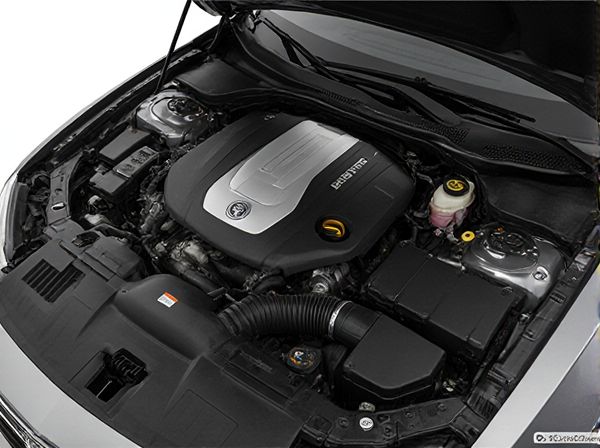
Photo illustration: Cylinder Deactivation vs Full Cylinder Operation
Cylinder deactivation improves fuel efficiency by shutting down some cylinders when full engine power is unnecessary, reducing fuel consumption and emissions. Full cylinder operation provides maximum power and performance by utilizing all cylinders continuously, ideal for demanding driving conditions. Your choice depends on whether you prioritize fuel economy or consistent engine power.
Table of Comparison
| Feature | Cylinder Deactivation | Full Cylinder Operation |
|---|---|---|
| Fuel Efficiency | Improves fuel economy by reducing fuel use during low load | Higher fuel consumption due to all cylinders active |
| Emissions | Reduces emissions by lowering fuel burn | Standard emission levels with all cylinders firing |
| Power Output | Lower power when some cylinders are deactivated | Maximum power with all cylinders operational |
| Engine Wear | Potential reduced wear due to fewer combustion cycles | Normal wear with continuous full operation |
| Complexity | Higher mechanical and software complexity | Simpler engine design and control |
| Noise & Vibration | Increased noise/vibration from cycling cylinders | Smoother operation with consistent firing |
Introduction to Engine Cylinder Management
Engine cylinder management technologies like Cylinder Deactivation (CDA) and Full Cylinder Operation (FCO) optimize fuel efficiency and emissions performance by adjusting the number of active cylinders based on driving conditions. Cylinder Deactivation selectively shuts down specific cylinders during low-load scenarios to reduce fuel consumption, while Full Cylinder Operation maintains all cylinders active to deliver maximum power and responsiveness. Advanced engine control units (ECUs) coordinate these modes seamlessly, enhancing engine efficiency without compromising performance or drivability.
Understanding Cylinder Deactivation
Cylinder deactivation enhances fuel efficiency by selectively disabling certain cylinders during low-load conditions, reducing fuel consumption and emissions without compromising engine performance. This technology dynamically adjusts combustion based on driving demand, unlike full cylinder operation where all cylinders fire continuously regardless of load. Understanding cylinder deactivation involves recognizing its role in optimizing engine output, improving mileage, and maintaining power when needed.
What Is Full Cylinder Operation?
Full Cylinder Operation refers to an engine mode where all cylinders are actively firing to produce maximum power and performance. Unlike Cylinder Deactivation, which temporarily disables some cylinders to improve fuel efficiency during low load, Full Cylinder Operation maintains continuous combustion in every cylinder to ensure optimal torque and acceleration. This mode is typically engaged during high-demand driving conditions such as rapid acceleration or towing.
Key Differences Between Cylinder Deactivation and Full Cylinder Operation
Cylinder deactivation improves fuel efficiency by shutting off select cylinders during low-load conditions, reducing fuel consumption and emissions, whereas full cylinder operation maintains all cylinders firing continuously for maximum power output. Deactivation systems rely on advanced engine management and variable valve timing to seamlessly transition between active and inactive cylinders, unlike full operation which has a constant combustion process. Performance-wise, cylinder deactivation prioritizes fuel economy and reduced wear, while full cylinder operation emphasizes consistent power and torque delivery.
Fuel Efficiency: Comparing Both Approaches
Cylinder deactivation improves fuel efficiency by shutting down select cylinders during low-load conditions, reducing fuel consumption and emissions without sacrificing full power when needed. Full cylinder operation maintains all cylinders active, ensuring maximum performance but consuming more fuel, especially during light driving. Optimizing fuel efficiency requires balancing deactivation benefits with the engine's load demands and driving patterns.
Performance Impacts: Power and Responsiveness
Cylinder deactivation improves fuel efficiency by shutting down select cylinders during low-load conditions, reducing fuel consumption without sacrificing overall engine durability. Full cylinder operation delivers peak power and maximum responsiveness by utilizing all cylinders continuously, ensuring optimal combustion and acceleration performance. While cylinder deactivation can slightly reduce immediate throttle response, it strikes a balance between fuel economy and power output, making it ideal for everyday driving conditions.
Emissions and Environmental Considerations
Cylinder deactivation reduces fuel consumption and lowers CO2 emissions by shutting off fuel delivery to select cylinders during light-load driving, thereby improving engine efficiency and decreasing environmental impact. In contrast, full cylinder operation maintains maximum power output but results in higher fuel consumption and increased greenhouse gas emissions. Choosing cylinder deactivation technology contributes to meeting stringent emissions regulations and supports sustainable transportation efforts by minimizing the carbon footprint of internal combustion engines.
Reliability and Maintenance Factors
Cylinder deactivation improves engine efficiency by selectively shutting down cylinders during low-load conditions, reducing wear and tear on certain components and potentially extending maintenance intervals. Full cylinder operation, while simpler in design, subjects all cylinders to constant use, leading to more uniform but potentially faster overall engine wear and higher fuel consumption. Reliability in cylinder deactivation systems depends on advanced control electronics and actuators, which may increase maintenance complexity compared to the straightforward mechanics of full cylinder operation.
Applications in Modern Vehicles
Cylinder deactivation technology improves fuel efficiency and reduces emissions in modern vehicles by selectively shutting off some cylinders during low-load conditions, commonly applied in V6 and V8 engines. Full cylinder operation provides maximum power and performance when demanded, ensuring optimal engine output for towing, acceleration, and high-speed driving. This balance allows vehicles to switch seamlessly between fuel-saving mode and full power, enhancing overall drivability and environmental compliance in hybrid and conventional internal combustion engines.
Choosing the Right System for Your Needs
Cylinder deactivation enhances fuel efficiency by shutting off select cylinders during low-load conditions, making it ideal for drivers prioritizing fuel economy without sacrificing power when needed. Full cylinder operation ensures maximum engine performance and reliability, preferred by those who require consistent power output for heavy-duty tasks or spirited driving. Assessing your driving habits and performance demands helps determine whether efficiency or uninterrupted power aligns best with your vehicle needs.
 caratoz.com
caratoz.com